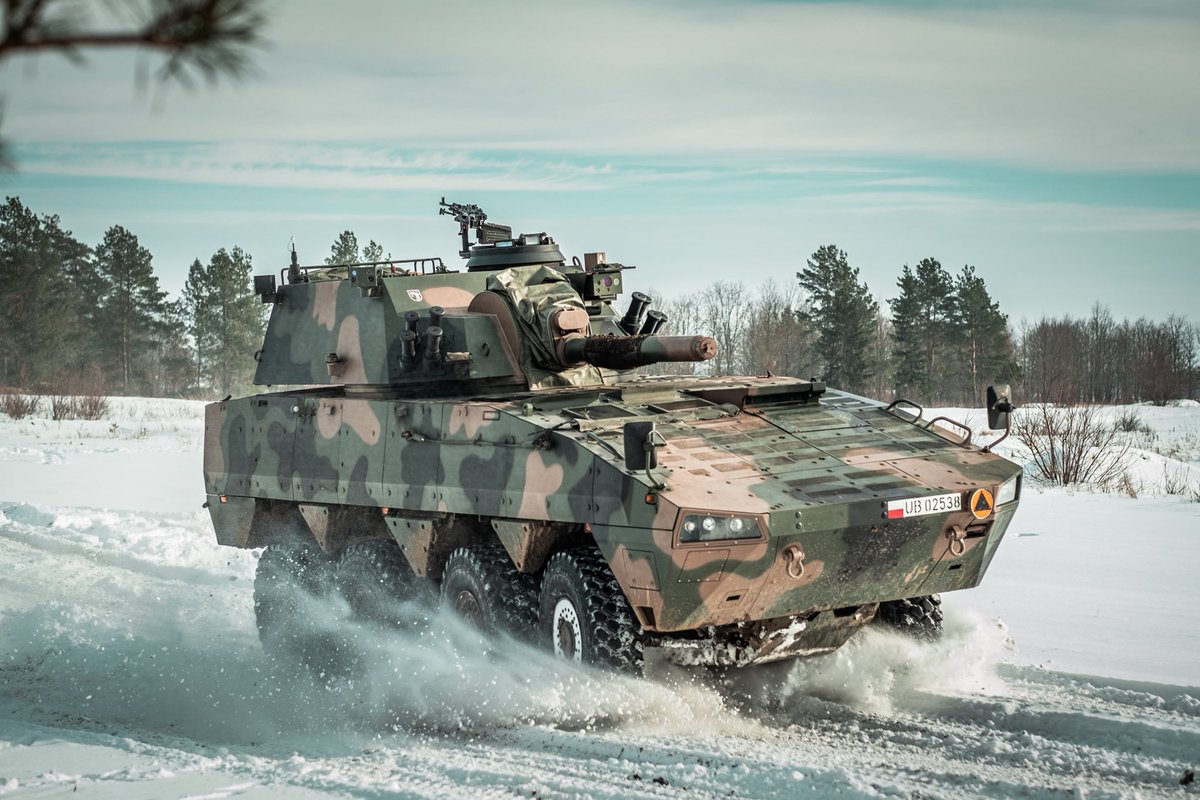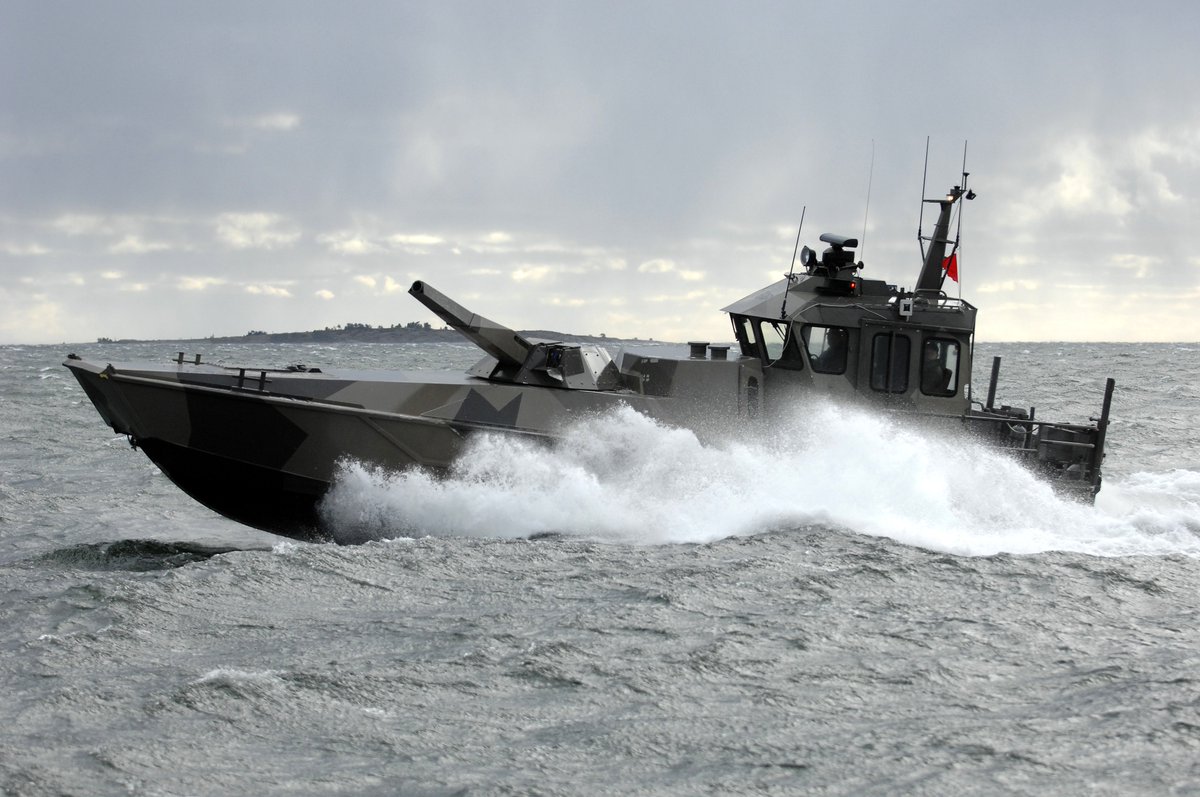A few weeks ago I did a thread about mortars - today I will do a thread about mortar carriers 🧵:
Mortar carriers are becoming more and more important on the battlefield due to their speed and high rate of fire; and Poland's fully automatic M120 Rak is the best of them all.
1/n
Mortar carriers are becoming more and more important on the battlefield due to their speed and high rate of fire; and Poland's fully automatic M120 Rak is the best of them all.
1/n

first army to use mortar carriers in battle. The initial M4 Mortar Motor Carriage (MMC) consisted of a M2 Halftrack with a 81mm M1 mortar that could be dismounted, while the later M4A1 MMC used the same mortar but in a fixed mount in the vehicle's rear.
3/n


3/n


In 1944 production was switched to the M21 MMC, which was based on the larger M3 Halftrack. In 1945 the two M4 and M4A1 MMCs were retired, while the M21 remained in service until 1968, when it was replaced by the most produced mortar carriers in history: the M106/M125 series.
4/n
4/n

In 1960 the US Army introduced the M113 Armored Personnel Carrier (APC), which became the standard APC for 12 of NATO's 16 Cold War era members. In total 80,000 M113 were produced (incl. for US allies all over the world).
5/n
5/n

In 1964 the US Army introduced two identical mortar carriers based on the M113 APC, with the only difference the mortar they used:
• M106: 107mm M30 rifled mortar
• M125: 81mm M29 smoothbore mortar
Some 2,600+ of the two variants were produced for the US and its allies.
6/n
• M106: 107mm M30 rifled mortar
• M125: 81mm M29 smoothbore mortar
Some 2,600+ of the two variants were produced for the US and its allies.
6/n

In both carriers the mortars were mounted on a turntable to allow firing to the sides.
The M106 also carried the M30's base plate and support arm on the left side of the M113 to allow for operating the mortar dismounted.
7/n
The M106 also carried the M30's base plate and support arm on the left side of the M113 to allow for operating the mortar dismounted.
7/n

In 1988 the US Army introduced the M1064 mortar carrier, which replaced the M106's M30 rifled 107mm mortar with the Soltam K6 smoothbore 120mm mortar. At total of 1,076 were acquired and as of 2023 are used by all US Army armor brigades.
8/n
8/n

US allies developed their own mortar carries, i.e. the British Army the FV432 mortar carrier with a 81mm L16 mortar or the Finnish Army the NA-122 with a 120mm KRH 92 mortar.
9/n


9/n


The drawback of all these mortar carriers is that their entire operation is manual: raising them, sighting them, loading them, etc.
This slows down and over times tires out the crews.
10/n
This slows down and over times tires out the crews.
10/n
After the Cold War development of self-laying mortars began. The first system to enter production was the Israeli Keshet, which consists of a M113 APC, the Cardom Recoil Mortar System (RMS) and a K6 120mm mortar.
The Cardom automatically raises and lays the mortar and
11/n
The Cardom automatically raises and lays the mortar and
11/n

automatically adjust the mortar after each round, which allows for a higher rate of fire.
The Cardom/K6 combination is also used by the US Army's M1129 Stryker Mortar Carrier (video) and in General Dynamics products like the Piranha V for the Danish Army.
12/n
The Cardom/K6 combination is also used by the US Army's M1129 Stryker Mortar Carrier (video) and in General Dynamics products like the Piranha V for the Danish Army.
12/n
The US Marine Corps went a different way and developed the Dragon Fire II mortar system, which used the French rifled MO-120 RT 120mm mortar.
Besides automatic laying and adjusting the Marines also wanted semi-automatic loading to cut down on crew fatigue from lifting the
13/n
Besides automatic laying and adjusting the Marines also wanted semi-automatic loading to cut down on crew fatigue from lifting the
13/n

mortar projectiles. The Marines never acquired Dragon Fire II, but Thales continued development. Today the systems is called 2R2M and is mounted in Italian Army Freccia mortar carriers (video), French Army VBMR Griffon vehicles.
14/n
14/n
A similar system with semi-automatic loading is RUAG's Cobra, which has been mounted on Swiss Army Piranha IV (photo).
Germany's Rheinmetall offers the manual loading VingPos, which has been mounted on Norwegian Army CV90.
All of these systems fire their mortars through an
15/n
Germany's Rheinmetall offers the manual loading VingPos, which has been mounted on Norwegian Army CV90.
All of these systems fire their mortars through an
15/n

open roof, which exposes crew and ammo to shrapnel from enemy artillery fire and enemy loitering munitions.
Therefore Germany (lePzMrs), Finland (AMOS/NEMO), Sweden (Mjölner), and Poland (M120 Rak) developed mortar carriers, which can fire their mortars, while crew and ammo
16/n




Therefore Germany (lePzMrs), Finland (AMOS/NEMO), Sweden (Mjölner), and Poland (M120 Rak) developed mortar carriers, which can fire their mortars, while crew and ammo
16/n




remain protected inside the vehicle.
The first vehicle ready for production was Germany's Leichter Panzermörser (lePzMrs) based on a heavily modified Wiesel 2 weapons carrier. Air transportable, with automatic laying and adjusting of the 120mm mortar, network capabilities,
17/n
The first vehicle ready for production was Germany's Leichter Panzermörser (lePzMrs) based on a heavily modified Wiesel 2 weapons carrier. Air transportable, with automatic laying and adjusting of the 120mm mortar, network capabilities,
17/n
and manual loading it was an excellent system... but under Merkel the German Army was starved of funding and only eight lePzMrs were acquired.
Sweden and Finland initially developed the AMOS twin-barreled, breech loading, semi-automatic mortar, which in turn was developed
18/n
Sweden and Finland initially developed the AMOS twin-barreled, breech loading, semi-automatic mortar, which in turn was developed
18/n

into the NEMO single-barreled, breech loading, semi-automatic mortar.
Patria ceased production of AMOS n favor of NEMO, which is a fantastic system: fast, agile, it can fire on the move, it can even be used as an assault gun (= fire at a target in its line of sight), but
19/n
Patria ceased production of AMOS n favor of NEMO, which is a fantastic system: fast, agile, it can fire on the move, it can even be used as an assault gun (= fire at a target in its line of sight), but
19/n
AMOS and NEMO have one drawback: as semi-automatic systems rounds have to be loaded into the loader by hand; and as the ammo magazine is mounted outside the turret the barrel has to swivel back to the forward position after each round so the next round can be loaded.
20/n
20/n
Sweden's Mjölner is a twin-barreled, muzzle loading, manual mortar ... yep, the entire loading process is manual: two loaders place the rounds onto a tray and then push the trays upward, where the rounds are then dropped into the barrels.
21/n
21/n
Mjölner is a decent system, NEMO is much better, but the best system is Poland's M120 Rak - the only fully automatic mortar system.
The Rak is a single-barreled, breech loading mortar, which a fully automatic magazine and autoloader in the turret, which allows the Rak to
22/n
The Rak is a single-barreled, breech loading mortar, which a fully automatic magazine and autoloader in the turret, which allows the Rak to
22/n

fire and reload now matter where the barrel is. The Rak turret carries 46 rounds can be mounted on either tracked or wheeled platforms. Poland ordered 122 and (supposedly) donated some 20 to Ukraine.
Rak and NEMO have very similar capabilities, with the RAK offering a
23/n
Rak and NEMO have very similar capabilities, with the RAK offering a
23/n
slightly higher rate of fire. Armies looking to buy a turreted mortar carrier will have a difficult time choosing between these two.
Armies looking to buy a turretless mortar system can chose between Cardom, 2R2M, Cobra, or VingPos (video shows Norwegian CV90 with VingPos).
24/n
Armies looking to buy a turretless mortar system can chose between Cardom, 2R2M, Cobra, or VingPos (video shows Norwegian CV90 with VingPos).
24/n
But all systems mentioned so far are meant for heavy armored or medium mechanized forces... what about light forces like paratroopers, or mountain infantry, or marines - well four systems vie for this market:
🇬🇧🇪🇸🇫🇷 Scorpion / Alakran / Sherpa
🇩🇪 Ragnarok
🇺🇸 Sling
🇮🇱 Spear
25/n




🇬🇧🇪🇸🇫🇷 Scorpion / Alakran / Sherpa
🇩🇪 Ragnarok
🇺🇸 Sling
🇮🇱 Spear
25/n




All of these systems use a 120mm mortars and are manually loaded. And all can be mounted on a wide variety of vehicles.
But the Israeli Spear has the advantage of being mounted onto the vehicle and thus is the fastest to be ready to fire and depart after a fire mission.
26/n
But the Israeli Spear has the advantage of being mounted onto the vehicle and thus is the fastest to be ready to fire and depart after a fire mission.
26/n
The US Army chose Spear for its light brigades and is mounting the Spear on Joint Light Tactical Vehicles (photo).
With counter battery fire a major threat the times of towed artillery, be it howitzers or mortars, is coming to an end. The future are automated systems, like
27/n
With counter battery fire a major threat the times of towed artillery, be it howitzers or mortars, is coming to an end. The future are automated systems, like
27/n

Archer, Zuzana 2, RCH 155, PzH 2000, Krab, or K9 self-propelled howitzers for heavy and medium forces, with systems like CAESAR for light forces.
Similarly towed mortars will become a niche capability reserved for air assault units, which rely on helicopters for mobility,
28/n
Similarly towed mortars will become a niche capability reserved for air assault units, which rely on helicopters for mobility,
28/n
with most light units using systems like the Sherpa or Spear, which provide faster deployment, higher rates of fire and improved precision.
Last but not least: the NEMO is such an excellent system that it can even be fired from small boats or from containers (2nd photo).
29/end


Last but not least: the NEMO is such an excellent system that it can even be fired from small boats or from containers (2nd photo).
29/end


• • •
Missing some Tweet in this thread? You can try to
force a refresh


















